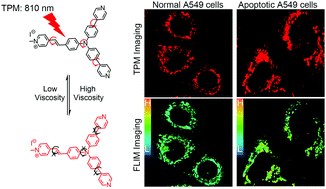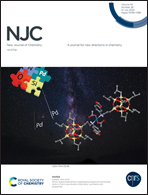A molecular rotor sensor for detecting mitochondrial viscosity in apoptotic cells by two-photon fluorescence lifetime imaging†
Abstract
Impairing mitochondrial function may change its viscosity. The detection of changes in the mitochondrial viscosity is of great significance for biomedical research. Herein, we have designed a D–π–A type two-photon fluorescent probe ((4-(bis(4-(pyridin-4-yl)phenyl)amino)styryl)-1-methylpyridin-1-ium iodide) (DPTPA-Py) with a triphenylamine derivative as the electron donor and pyridinium as the electron acceptor for detecting mitochondrial viscosity in living cells. It is found that both fluorescence intensity and fluorescence lifetime of DPTPA-Py are viscosity-dependent, and the probe exhibits a strong anti-interference ability in the detection of viscosity. The colocalization experiments reveal that DPTPA-Py is located in mitochondria only and is highly biocompatible. The probe shows no significant effects on the mitochondrial membrane potential. In addition, the probe is successfully used to monitor mitochondrial viscosity changes during apoptosis of living cells by two-photon microscopy (TPM) and fluorescence lifetime imaging microscopy (FLIM).



 Please wait while we load your content...
Please wait while we load your content...